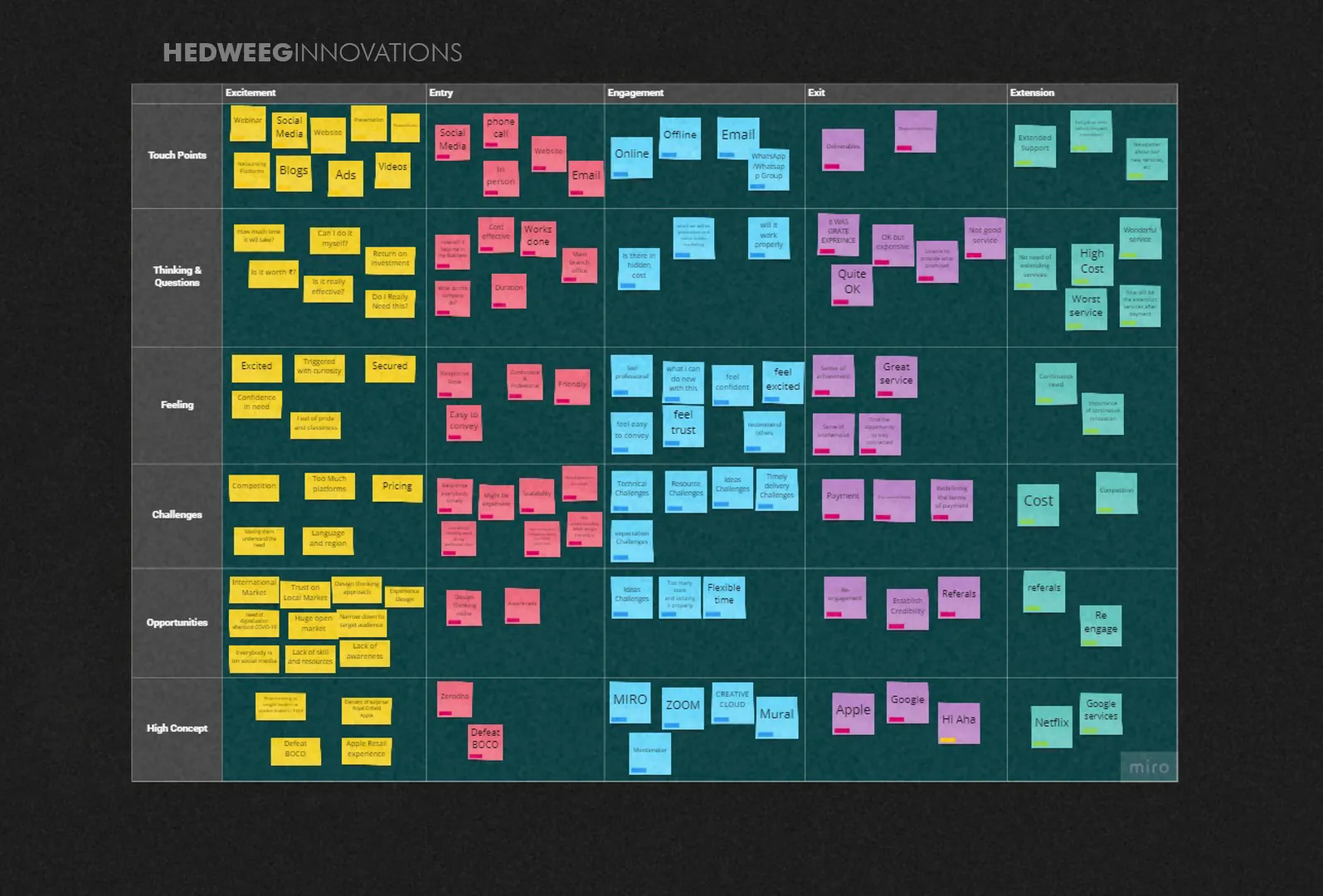
A customer journey map is a visualization of customer experience, which illustrates all the places, touchpoints customers came into contact with your brand, online, or offline.
Once you finish the research, it’s time to start mapping out the customer journey, where you closely observe every action and behaviour of the customer.
Mapping includes customer sentiments, delights, pain points, touchpoints, and opportunities placed in chronological order. It helps you look at your brand, product, and processes through the customer’s eye, so that you can craft a better experience for them.

Why —
The goal is to encourage human-centeredness and help designers and stakeholders to understand how their customers’ needs and feelings fluctuate throughout their journey. With this understanding, teams can better identify underlying opportunities for innovation and improvement. Customer journey mapping is a strategic approach, a guide map to discover expectation, to get valuable insights. It is crucial for optimizing the existing customer experience and converting it into a better personalized experience, across the touchpoints, to help business thrive.
6 Steps of mapping customer journey —
-
- Set a clear goal for the map
Goal provides clarity on,-
- What do we want to achieve? E.g.: Think, what is the goal of a healthy food brand — Might be to attract health conscious families to the website.
- What sort of data we are seeking for?
- What insights do we hope to gain?
-
- Use personas to highlight the target audience
-
- Personas are a great source of information to map effectively.
- It helps to gain deep insights.
E.g.: Sarah is 36 year old housewife, who actively looking for a website, that she can order variety of healthy food, for her husband and 2 children.
-
- Define customer journey stages
Stages portray, a sky view of…-
- Where the customers start their journey
- Where they go for purchase
- What they feel and do after purchase
-
- List out all the touchpoints
-
- Identifying all the touchpoints precisely will open the area of opportunities to craft great experience.
-
- Find out pain or friction points
-
- Remember, customers used to avoid asking for help.
- Observe them closely and pay attention to the points where the customers facing difficulties, and problems in the process.
- Touchpoints will help to reveal those pain areas, which need to be corrected.
-
- Validate the improvements
-
- Rewind the journey once again, for backend improvements and changes
- Keep taking feedbacks from customers
- Ask professionals, consult with experts to solve the complex problems
- Keep experimenting and learning
-
- Set a clear goal for the map
Customer Touchpoints
Touchpoints are a series of contact points a customer pass with during his visit (before, during, or after they make a purchase). This also includes moments that happen offline/online, through marketing, in person, or over the phone. Designing touchpoints carefully creates a conscious or subconscious impact. It communicates effectively with the customer and thus, lead to a better customer experience.
E.g.: Sitting at the restaurant table, what are the first things customers with interact with?
It might be, a table, a food menu or a glass of water
Table must be clean and well arranged or location of the table. Menu should be well designed. The temperature of the water should be ideal.
Identify touchpoints,
See from your customers’ vision and list out all of the places and times, the customer might interact with your brand. Here is the list, to start your exploration journey,

Try to score high in all of the touchpoints as it,
-
- Converts a simple visit into a beautiful purchase experience.
- Improves overall customer satisfaction, retention, and engagement ratio
- Ensures customers’ delight, at every footstep with your brand
- Is very cost-effective on ROI ratio
- Builds positive and unique/standout brand identity
5A Journey
5A journey is a versatile tool that helps you in designing the customer journey simply and effectively. It is modern customer journey mapping technique, designed considering the online buying journey of a customer, also can be used for offline buying journeys as well.
5A Model breaks down a customer’s journey into 5 simple phase:
-
- Aware
- Appeal
- Ask
- Act
- Advocacy
Let’s dive in each and understand better,
Aware:
Awareness is a form of advertising, that caught prospects’ attention and makes them existed, interested, inspired to take action, to interact with your products or service. E.g.: Print ads, TV ads, Digital marketing, Social media, Radio Ads, Search Ads, Online Ads
Appeal:
If the awareness is generated properly, the ads start to grab his attention. This stage tries to keep him engaged, through retargeting ads to increase the chances of future purchase.
Ask:
When he perceives these repetitive ads, it entices curiosity. Drives him to search more about the product. He might chat with family members, friends, neighbours, office colleagues, people around his atmosphere, or visit social media, website, physical store for clarity and feedbacks, before the purchase.
Act:
If he found healthy feedbacks from people, positive reviews from the website and satisfied with a visit to a near store, he finally makes the purchase and becomes a customer. He might purchase from online/offline platforms.
Advocacy:
This is the final phase of the journey. The customer becomes an advocate of the brand/product when he is satisfied with the whole purchase journey, the experience received, quality, and after sales service. When a customer shares his feedback with his friends, it results in more customers, and on the flip side, dissatisfied customers or bad reviews may harm the reputation.

To delight and retain customers, we need to become experts on the journey that our customers walk.
5E Experience Model
5E is a design model to brainstorm different stages of customer experience.It helps you design customer journeys quickly and easily. Each stage defines — customers’ thoughts, footprints, as well as their positive and negative feelings and additionally uncovers the hidden opportunities and challenges too.

Steps through analysis
Each step helps to analyze what customers do/think/feel, what are the challenges, opportunities we discover at every stages the customer passes with.
Touchpoint:
Customer interaction points
Thinking & Question:
What are the customers might be thinking? or What questions they might have?
Feeling:
What do you want your customers to feel at this stage?
Challenges:
What are the potential challenges in making this a smooth touchpoint?
Opportunities:
What are the opportunities that can be leveraged?
High Concept:
How do you reinforce with a visual example or does it reflect the real intention?
Take a whiteboard and start mapping our the path, you want to make your customer walk…

Once the entire journey mapping is done, it will help you identify all the moments those matter to customers and while brainstorming, it helps immensely to ensure that our focus on those moments and craft an extra ordinary experiences for our customers.
Lastly to conclude, spend enough time in research and journey mapping, because they define the base and direction for your brainstorming. Ensuring that you are doing ideation for right problem is more important.


